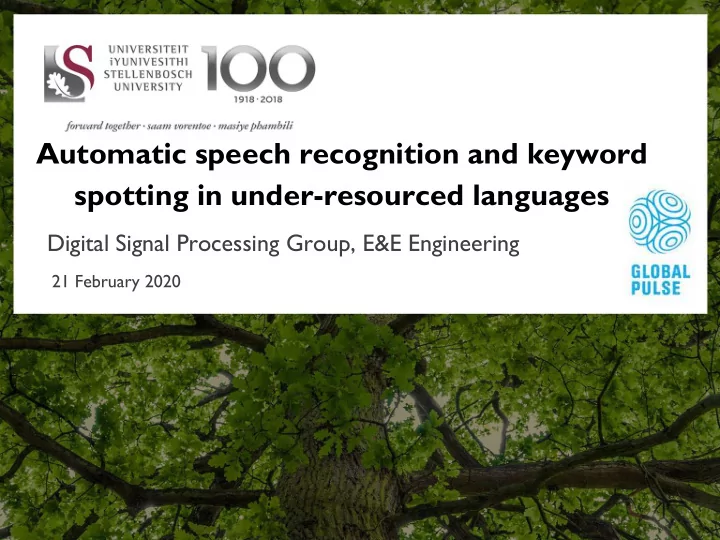

Automatic speech recognition and keyword spotting in under-resourced languages Digital Signal Processing Group, E&E Engineering 21 February 2020
DSP group
DSP group: More than speech http://dsp.sun.ac.za/~trn ● Communication network for wildlife sensors ● Optimised kinetic energy harvesting ● Automatic detection and classification of coughing in audio ● Virtual reality visualisation and analysis of microscopy data ● Sensor network for viticulture ● Interactive document visualisation for the blind
Automatic Language Processing: Then
Automatic Language Processing: Now
Language usage in South Africa
Multilingual corpus of code-switched South African speech
English – isiZulu CS speech
UN project
Target Languages Speech data • Ugandan English (6h), Luganda (9h), Acholi (9h, 12min) • Somali (1.6 h) • UE was augmented with SAE data (20h) Text data • 109 million SAE words • 1 million Luganda words (online newspaper) • Transcriptions of the audio data Pronunciation rules : Phonetic experts
ASR-free CNN-DTW keyword spotting
Acoustic modelling Acoustic models: data perturbation • Convolutional Neural Networks (CNNs) • Time-Delay Neural Networks (TDNNs) • Bi-directional Long Short-Term Memory NN (BLSTMs) Language models: data augmentation • Recurrent Neural Networks (RNNs) • Long Short-Term Memory Neural Networks (LSTMs)
Somali speech recognition Multi-pass semi-supervised training
ASR-free CNN-DTW keyword spotting
ASR-free CNN-DTW keyword spotting Aim: • Rapid deployment of keyword spotting systems in new languages Idea: • Use Dynamic Time Warping (DTW) as supervision to train Convolutional Neural Networks (CNNs) using small set of isolated keywords • Recordings of keywords are used as exemplars in DTW template matching, apply to untranscribed speech • Use DTW scores as targets to train CNN on same unlabelled data • Very little labelled data is required but large amount of unlabelled data can be leveraged
Features for ASR-free keyword spotting • Query-by- example: search “string” provided as audio • Use Dynamic Time Warping to match query with utterances in search collection • Various feature representations investigated, e.g. Multilingual bottleneck features (2 & 10 languages) • Stacked autoencoder • Correspondence autoencoder • Combinations of these •
Results • Multilingual feature extraction combined with target language fine- tuning can be complimentary • CCN keyword spotting does not match DTW-based system • BUT outperforms CNN classifier trained only on keywords • Main advantage of CNN: orders of magnitude faster at runtime than DTW • Feature extractors trained on well-resourced datasets can improve performance • Best performance: CAE trained on BNF
CNN DTW
Correspondence autoencoder
Keyword spotting examples
Current work Mali • More volatile environment • Difficult to install transmitters without raising suspicion • Bambara, Fulani • Some transcribed data, no text
Recommend
More recommend